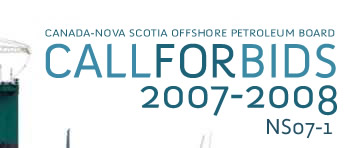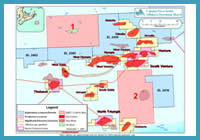
CANADA-NOVA SCOTIA OFFSHORE PETROLEUM BOARD


Regional Resource Potential

FIGURE: 9
Areal distribution of historical petroleum resource and reserves assessments offshore Nova Scotia, 1976-2007.
Areal distribution of historical petroleum resource and reserves assessments offshore Nova Scotia, 1976-2007.
The first published report on the resource potential for offshore Eastern Canada was the "Oil and Natural Gas Resources of Canada, 1976" published by Energy, Mines and Resources Canada (1977). Eastern Canada was divided into regions and the "Atlantic Shelf South" covered the entire continental shelf off Nova Scotia and Newfoundland up to latitude 46 degrees north. The hydrocarbon potential (including discoveries) median value (P50) was estimated at 368 E9M3 (13 Tcf) of gas and 300 E6M3 (1.9 BBbls) of oil and liquids. Using data available to the end of 1975, six small gas and oil fields had been discovered in the Sable Island area totaling about 28 E9M3 (1.0 Tcf) and 16 E6M3 (100 MBbls) respectively. Based solely on the pro-rating of areas, one-third was attributed to the Scotian Shelf, i.e. 155 E9M3 (4.4 Tcf) gas and 100 E6M3 (633 MMBbls) oil. The areal coverage of the various assessments discussed here, and the location of the basin's depocentres and features can be found in Figure 1 and Figure 9 respectively.
The GSC's report by Proctor et al. (1984) defined the physiographic Scotian Shelf to the 1500 m isobath. Discovery totals were listed as 110 E9M3 (3.9 Tcf) gas and 14 E6M3 (90 MMBbls) oil. The overall P50 potential (including discoveries) was reported as 509 E9M3 (18 Tcf) and 72 E6M3 (454 MMBbls). In addition, the George's Bank was assessed separately at 150 E9M3 (5.3 Tcf) and 175 E6M3 (1.1 BBbls). Previously, Nantais (1983) provided a detailed review of the petroleum systems of the Scotian Shelf, though he did not assess and generate potential hydrocarbon reserve and resource numbers.
The GSC 1984 report has been the benchmark assessment for the Scotian Shelf for the last 20 years and the 18 Tcf figure became a widely quoted number and rightly so. However, in light of the 42 wells drilled in the basin since their 1982 data cutoff, and the discovery of 116 E9M3 (4.1 Tcf) gas and 14 E6M3 (91 MMBbls) of oil, it became obvious that a new regional assessment was required.
In 1989 the GSC expanded the 1984 report by assessing the basin on the basis of play types (Wade et al., 1989). It determined that the overall gas number remained at 509 E9M3 (18 Tcf) but with a significant increase of oil and condensate potential to about 159 E6M3 (1.0 BBbl). The population of anomalies for each play type was based on cumulative anomaly mapping from COGLA of data submitted by Industry over the years that entered the public realm.
The GSC later published a paper on the petroleum geology of the Laurentian Sub-basin (MacLean and Wade, 1992). This sub-basin lies to the northeast of the Sable Subbasin juxtaposed to the Scotian Shelf and according to the distribution of anomalies defined by the authors, about 25% of the potential 249 E9M3 (8.8 Tcf) and 100 E6M3 (630 MMBbls) were assumed to exist in Nova Scotia waters. However, with the recent inter-provincial boundary decision of March 2002, little of that potential now lies within the CNSOPB's jurisdiction.
In 1997, several publications addressed the discoveries in the Sable Island area. The Sable Offshore Energy Project (SOEP) consortium submitted their Sable Development Plan application and assigned a recoverable gas amount of 85 E9M3 (3 Tcf) to the six fields; Venture, Thebaud, North Triumph (Tier 1) and Alma, South Venture and Glenelg (Tier 2) (SOEP, 1997). In March 1997, the Board published a technical report on all 22 discoveries that had been granted Significant Discovery status (CNSOPB, 1997, 2000). They supported the aforementioned 85 E9M3 (3 Tcf) figure for the six fields, and with new values for the remaining significant discoveries raised the cumulative total to 133 E9M3 (4.7 Tcf) recoverable gas.
Also in 1997, the Canadian Gas Potential Committee (CGPC) published a gas assessment for Canada but numbers for offshore Nova Scotia were limited to the Sable Subbasin (CPGC, 1997). They used the discovery data from the Board (133 E9M3 / 4.7 Tcf recoverable gas) and, for the first time, an undiscovered potential was calculated at 229 E9M3 (8.1 Tcf). The total for the Sable Subbasin was therefore noted as 362 E9M3 (12.8 Tcf).
Within the CGPC's 2001 Report on the Gas Potential of Canada, the Scotian Basin was addressed in its geological entirety that included offshore Nova Scotia and southeastern Newfoundland (Wade and MacLean, 1990). To cope with the lateral variations across the Scotian Basin, it was subdivided into ten geological entities of sub-basins or play areas. This analysis was the first attempt to assess the basin by its various components. A three-fold play category was employed; established or proven (i.e. having sufficient drilling data to carry out an assessment) and conceptual (where only qualitative descriptions could be accomplished).
Once again, the only established play area that could be fully assessed was the Sable Subbasin. An anomaly map released by the Nova Scotia Petroleum Directorate (1999: Sourced from original CNSOPB and COGLA compilations) was used to guide the assessment. The defined "Panuke Segment" of the Late Jurassic Abenaki Carbonate Bank Edge, although a proven play (EnCana press releases), could only be assigned a value for the one discovery since technical information was still confidential at that time. Finally, the conceptual plays were assessed with assigned geologic risk factors because the petroleum systems were unproven.
The results were 147 E9M3 (5.2 Tcf) recoverable gas in the Sable Subbasin, plus an undiscovered recoverable potential of 136 E9M3 (4.8 Tcf) for a combined total of 283 E9M3 (10.0 Tcf). The Panuke segment of the Late Jurassic Abenaki Carbonate Bank Edge was assigned 28 E9M3 (1.0 Tcf) recoverable gas based on the Deep Panuke discovery. The Abenaki Subbasin and Orpheus Graben were assessed at a mean risked gas-in-place of 201 E9M3 (7.1 Tcf) and 37 E9M3 (1.3 Tcf) respectively. Expressing the above in risked mean recoverable terms, the total was 467 E9M3 (16.5 Tcf) gas.
In late 1998, PanCanadian (later to become EnCana), made a significant gas discovery on the reef margin facies of the Late Jurassic Abenaki formation, located beneath its Panuke oil field (Early Cretaceous Missisauga formation). After delineation and exploration drilling, they filed a Development Plan in 2002 (PanCanadian, 2002). PanCanadian's probabilistic OGIP reserves estimates for Deep Panuke were 31 E9M3 (1.09 Tcf) (P50) / 33 E9M3 (1.16 Tcf) (EV - Expected Value, Mean). This Development Plan was later withdrawn, resubmitted in 2006, and approved by the CNSOPB in late 2007 (EnCana, 2006). The revised OGIP reserves estimates are 28.8 E9M3 (1.02 Tcf) (P50) / 29.2 E9M3 (1.03 Tcf) (EV, Mean), with recoverable gas (RGIP) conservatively estimated to be 18.3 E9M3 (645 Bcf) (P50) / 18.7 E9M3 (659 Bcf) (EV, Mean).
In its latest 2005 report, the CPCC incorporated a number of industry, consultant, government and regulatory reports, publications and assessments in its determination of resources and reserves for the Scotian Basin (CGPC, 2005). It duplicated its previous 2001 assessment framework and determined that the basin's total gas-in-place P50 gas resource is 1192 E9M3 (42.1 Tcf), of which 212 E9M3 (7.5 Tcf) has been discovered and 980 E9M3 (34.6 Tcf) undiscovered, a 53% increase from the 2001 report. Within the Sable Subbasin, overall reserves and resources estimates were reduced based on production information from the five SOEP fields in production, recent exploration drilling and revisions to field size distributions. Liquid petroleum resources were not assessed.
Following industry's drilling of six deep water exploration wells, the CNSOPB reevaluated its 2002 assessment of the Scotian Slope (CNSOPB, 2007). It concluded that its original estimates were modestly affected by the recent drilling given that most of the 12 plays assessed remained undrilled: one well tested a subsalt play, another an interpreted Tertiary fan (a play type not included in the 2002 assessment), and the remaining four testing anticlinal structures clustered outboard of the Sable Delta. While gas was discovered in two of the four wells, this latter play was slightly downgraded with higher risks assigned to presence of reservoir.
The reassessment of three of the 12 plays reduced the risked mean recoverable gas from 430 to 328 E9M3 (15.2 to 11.6 Tcf), a reduction of 102 E9M3 (3.6 Tcf) or 24%. Similarly, the unrisked mean recoverable was reduced from 1164 to 1090 E9M3 (41.1 to 38.5 Tcf), a reduction of 26 E9M3 (2.6 Tcf) or 6%. The net result is the undiscovered gas potential of 425 to 1164 E9M3 (15 to 41.1 Tcf) has been revised to 340 to 1104 E9M3 (12 to 39 Tcf), a modest reduction within the overall range of probabilistic analysis.
The risked recoverable oil fraction was similarly reduced from a mean of 270 to 207 E9M3 (1.7 to 1.3 BBbls), and the unrisked mean was reduced from 4.7 to 4.5 BBbls.
In summary, the historical assessments illustrate the region's limited, but robust assessment history. However, over the years these assessments have steadily improved knowledge of the region's hydrocarbon endowment, and have laid the foundation upon which higher resource numbers will be forecast as more of the basin and its plays are explored and come under quantitative analysis.